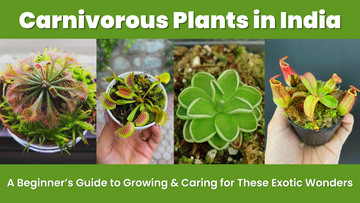Are you fascinated by the mysterious world of carnivorous plants? These unique plants have evolved to thrive in nutrient-poor environments by trapping and digesting insects. Despite their exotic nature, growing them at home is easier than you think! This comprehensive guide will help you understand how to choose, grow, and care for carnivorous plants in India, ensuring they thrive in your home or garden.

Table of Contents
- What Are Carnivorous Plants?
- Popular Types of Carnivorous Plants
- Can You Grow Carnivorous Plants in India?
- How to Choose Your First Carnivorous Plant
- How to Grow Carnivorous Plants (Complete Care Guide)
- Common Problems & How to Fix Them
- Where to Buy Carnivorous Plants in India
What Are Carnivorous Plants?
Carnivorous plants are unique species that have adapted to capture and digest insects for nutrients. These plants thrive in nutrient-poor environments where regular plants would struggle to grow. Their trapping mechanisms include:
- Snap Traps: e.g., Venus Flytrap
- Pitfall Traps: e.g., Pitcher Plants
- Sticky Traps: e.g., Sundews
- Suction Traps: e.g., Butterworts
Popular Types of Carnivorous Plants
1. Venus Flytrap (Dionaea muscipula)
Famous for its jaw-like trapping mechanism. Requires high humidity and full sunlight. Grows best in nutrient-free soil.
Click here to buy Venus Fly trap

2. Pitcher Plants (Nepenthes, Sarracenia, Cephalotus)
Have deep, liquid-filled pitfall traps. Some species are native to India (Meghalaya & Western Ghats). Thrive in humid conditions.
Click here to Buy Pitcher Plant

3. Sundews (Drosera species)
Covered in sticky tentacles that trap insects. Extremely hardy and easy to grow. Can thrive in waterlogged conditions.

4. Butterworts (Pinguicula species)
Have flat, sticky leaves that trap insects. Produce beautiful flowers. Great for catching fungus gnats indoors.

Can You Grow Carnivorous Plants in India?
Yes! Many carnivorous plants can adapt to Indian climates with proper care. Some species are even native to India, such as Utricularia (Bladderworts) and Nepenthes (Pitcher Plants).
How to Grow Carnivorous Plants (Complete Care Guide)
1. Potting & Soil Requirements
Use a nutrient-free soil mix (Sphagnum moss + Perlite). Avoid regular garden soil or compost.
2. Lighting Needs
Outdoor plants need at least 6 hours of direct sunlight. Indoor plants thrive under strong grow lights.
3. Watering Instructions
Use only distilled, RO, or rainwater. Keep the soil moist but not flooded.
Common Problems & How to Fix Them
Here are some common issues you may face and how to resolve them:
- Venus Flytrap Turning Black: Overfeeding, poor water quality, or lack of light.
- Pitcher Plant Not Forming Pitchers: Low humidity or insufficient lighting.
- Carnivorous Plant Dying: Incorrect soil, tap water, or lack of humidity.
Where to Buy Carnivorous Plants in India
Finding carnivorous plants in India can be challenging, but you can buy them from:
- Online plant nurseries (Perfectplants.in)
- Specialty gardening stores
- Local botanical gardens
Frequently asked Question (FAQs)
1. What are carnivorous plants, and how do they work?
Answer: Carnivorous plants are unique species that trap and digest insects to obtain nutrients. They grow in nutrient-poor environments and have specialized traps such as snap traps (Venus Flytrap), pitfall traps (Pitcher Plants), and sticky traps (Sundews) to catch prey.
2. Can I grow carnivorous plants in India?
Answer: Yes, you can grow carnivorous plants in India! Some species like Nepenthes (Pitcher Plants) and Utricularia (Bladderworts) are native to India. With proper care, these plants can thrive in Indian climates, especially in humid regions.
3. Which is the easiest carnivorous plant to grow for beginners?
Answer: The easiest carnivorous plants for beginners are Venus Flytraps, Sundews (Drosera), and Nepenthes (Tropical Pitcher Plants). They require minimal care and can adapt to a variety of conditions.
4. Where can I buy carnivorous plants in India?
Answer: Carnivorous plants are available in select plant nurseries and online stores in India. Check trusted nurseries and specialty gardening websites to find healthy and thriving plants.
5. What kind of soil do carnivorous plants need?
Answer: Carnivorous plants need nutrient-free soil, typically a mix of sphagnum moss and perlite. Avoid regular garden soil or compost, as it contains nutrients that can harm these plants.
6. How often should I water my carnivorous plants?
Answer: Carnivorous plants require consistent moisture. Use distilled, reverse osmosis (RO), or rainwater. Keep the soil moist but avoid waterlogging for species like Venus Flytraps and Nepenthes.
7. Do carnivorous plants need direct sunlight?
Answer: Yes, most carnivorous plants thrive in bright, direct sunlight. Venus Flytraps and Sundews require at least 4- 6 hours of sunlight daily. If grown indoors, use strong grow lights to meet their light requirements.
8. Can I feed my carnivorous plants insects?
Answer: Yes, you can feed carnivorous plants live insects like ants, flies, or small crickets. However, it’s not necessary if they are grown outdoors, as they naturally catch insects on their own.
9. Why is my Venus Flytrap turning black?
Answer: A Venus Flytrap may turn black due to overfeeding, poor water quality, or insufficient light. Use distilled water, ensure adequate sunlight, and avoid feeding it too often to prevent this problem.
10. What temperature and humidity do carnivorous plants need?
Answer: Most carnivorous plants thrive in warm and humid conditions. Keep the temperature between 20–30°C and humidity above 50%. Sundews and Nepenthes prefer higher humidity levels, while Venus Flytraps can adapt to moderate conditions.



